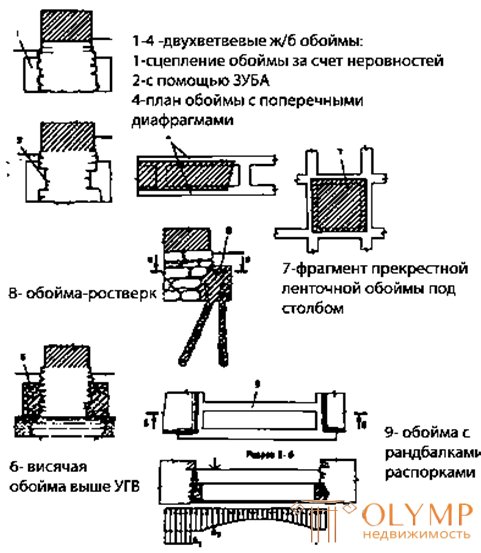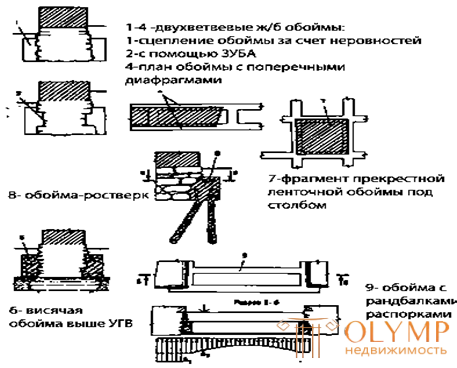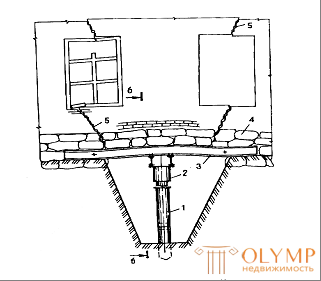
Laying of foundations is one of the most well-known and often used methods of strengthening buildings, which consists in increasing the footing area and deepening the foundation by partially or completely replacing the old foundation structure. The liner of the strip foundations is carried out by sections (“grabs”), the length of which depends on the strength of the overlying masonry (walls, basement, foundations), the presence of openings in it, cracks, and also on the depth of foundation of the foundations. Relatively short claws of 1.5–2 m under blank walls that allow for pressure transfer are usually performed without fastening. When laying the foundations in difficult conditions (large depth, crumbling masonry, concentrated load) a temporary fastening of the clamp in the form of racks, transverse or longitudinal frames, distribution beams, etc.
The design of the temporary attachment should take into account the possibility of placing armo carcasses and formwork, as well as rearrangement or dismantling (Fig.9.2).

The supplied part of the foundation is usually made of monolithic concrete or reinforced concrete, rubble is sometimes used. The order of opening and casting of the grapple is assigned from the condition that each open and concreted grapple is under the protection of the adjacent area.
A significant difficulty is the laying of foundations for detached pillars, pylons, loaded piers, etc. In this case, the opening order of the grips should exclude the long-term non-central compression of the masonry and the base. Reinforced pillars and walls must be maximized.
The Assumption Cathedral in Ryazan, the Cathedral of the Nativity of the Virgin and the fortress walls of the Pafnutiev-Borovsky monastery, many monuments of the Kirillo-Belozersky monastery, etc. were strengthened by laying the foundations.
The conditions for the optimal application of this method are considered:
- considerable length of reinforced structures;
- the ribbon character of the foundation and the absence of a concentrated load on it;
- solidity of reinforced walls and foundations, regular masonry (brick or white stone), the absence or small amount of low-lying openings and cracks;
- small depth of the supplied foundations (up to 2-2.5 m);
- low standing of groundwater;
- sufficient bearing capacity of base soils - not less than 0.15 MPa.
Strengthening foundations with clips. In cases where the laying of foundations is difficult or there is a danger of new subsidence deformations (with unqualified uncontrolled production), existing foundations can be strengthened and expanded with the help of lateral applications in the form of individual concrete blocks, tapes or holders. Additional applications or clips are calculated either on the excess part of the load (according to the bearing capacity of the base), or on the perception of the full load, which implies an appropriate contact between the foundation and the concrete structure.
The method of connecting the old and new parts of the foundation depends on the size of the transmitted load, the contact area, the nature of the old masonry, etc. If, for example, the functions of the clips are planned to be moderate (up to 30% of the total pressure), and the ancient foundation is composed of boulders and rubble, then for reliable transfer of the load can be quite simple adhesion of concrete with uneven masonry. For dense white-stone or brick foundations, keyed connections are used with a clip in the form of a concrete "tooth", transverse metal beams or reinforcing bars. The size of the "tooth" is calculated on the resistance of the soil on the splitting of the less durable of the joined materials, and the length and number of metal dowels - on the crushing of the foundation material. In addition to the shearing force, the keyed joints also experience tensile forces, which are the higher, the larger the bearing area of the clips and the smaller their height. The complexity of the through transverse reinforcement of the foundations, the anchoring of the reinforcement and its protection against corrosion does not allow us to consider the wide clamps as rational and long-lasting reliable structures (Fig. 9.3).
The best results are given by narrow two-branch clips or single clips closed along a limited contour and not experiencing torque.
If necessary, significantly increase the supporting area of the foundation can be recommended cross-cage, in which the resistance of the soil loads and "free", not related to the foundations of the elements.
Cross-clip systems are designed to strengthen a number of monuments of Novgorod (Znamensky Cathedral, 1682, the Spasskaya Tower of the Kremlin, 1485). In Moscow, this method was successfully applied to strengthen the Gate Church of the Danilovsky Monastery (restoration, 1983-1985).
In some cases, the construction of the clips allows them to be used as pile foundations. Piles can be installed either in advance, prior to concreting of the grillage, or secondarily, when the holder already exists and the need for its strengthening arises.
With all the differences in design and purpose of the clips, they have one common feature - they do not violate the existing contact between the base of the foundation and the base.

Figure 9. 3 - Strengthening the foundations with the help of clips
Pile and combined methods of foundation reinforcement.
An interesting type of reinforcement of masonry walls and foundations, as well as the foundation soil, can be considered as their reinforcement by the so-called “root-shaped”, or drilling and injection piles (Fig. 9. 4).
The brown injection piles, developed over 30 years ago by the Italian company Fondedaille, are successfully used to strengthen the volume of architectural monuments and modern buildings with their deformations, subsidence, and increased loads. Retaining walls, embankments, landslides, slopes and walls of deep workings also strengthen root-shaped piles.
A pile injection pile is a hole 75–150 mm in diameter, reinforced with 1-3 rods and filled under a pressure of 2–4 atm. cement-sand mortar. Drilling is performed by electric rotary drilling machines to a depth of 10-30 m and more at any angle to the vertical. Drilling of stone walls and foundations is made with a roller bit, the precautions when drilling loose, unstable masonry are approximately the same as when drilling anchor holes.

Fig. 9.4. - Brown injection piles
Excessive pressure created during the crimping of the pile, allows to fill with a solution not only the pile shaft, but also the intersections of the void, shell, cracks and empty seams. Thus, filling the pile, drilled through the masonry of the basement or foundation, contributes to monolithing and strengthening this masonry.
Depending on the dimensions of the structure to be strengthened, the type of load and deformation, the injection piles can be used as rigid, compressed, compressible-bending and stretched rods.
The bearing capacity of a brown injection pile depends on its working scheme (pile-up or hanging pile), geology of the site, quality of filling and pressure testing.
The use of injection piles is irrational in the following cases:
-  when boulder foundations are strengthened, since drilling is difficult, and the “embedding” of the pile in the basement body (as well as its injection) is carried out poorly but due to the discrepancy between the physical and mechanical properties of the injection solution and the non-porous material of the boulders;
when boulder foundations are strengthened, since drilling is difficult, and the “embedding” of the pile in the basement body (as well as its injection) is carried out poorly but due to the discrepancy between the physical and mechanical properties of the injection solution and the non-porous material of the boulders;
- when strengthening archaeological ruins or other structures of weak, crumbling material that does not withstand the dynamics of drilling;
- with unfavorable geology of the site and the need for extremely deep drilling.
Rostverki using bored piles. Bored piles can be used to create foundation structures, partially duplicating old foundations or completely unloading them. The pile structure is formed when concrete is filled with a well specially drilled in the ground (and reinforced with a welded skeleton) with a diameter of more than 200 mm. Unlike root-shaped piles, bored piles pass only through the ground and only outside the building at a distance of at least 1-1.5 m from the line of reinforced walls. The transfer of the load on the removed pile foundation is carried out with the help of transverse beam structures, which are the more complex and lengthy the more widely placed the axes of the piles are.
The method is applicable, therefore, to structures of relatively small width (up to 6 m), fortress walls, pylons, pillars, buttresses, small towers and bell towers, narrow buildings. A limiting factor is a certain difficulty in the sinking of the bolt (under the foundation and through the foundation) and the placement of drilling machines. A prerequisite for the application of the method may be a very large linear (or concentrated) load on the foundation in combination with poor geology of the site.
Impressed piles , like bored piles , are used when it is necessary to perceive very large loads of the reinforced structure with unfavorable geology of the site.
The method of crushing piles consists in immersing piles under foundations or walls of a building with the help of a jack resting against a distribution beam in the foundation slab. Thus, the building mass is used as a pile driving load. The maximum force developed by the jack must correspond to the state of equilibrium between the load bearing capacity of the pile (according to the material of the pile and the ground) and the load on it (Fig. 9.4).
Impressed piles are metal or reinforced concrete sectional structures, which are increased as sections are submerged. The jack is attached (suspended) to the traverse (naddkratsevnoy beam), which is filled with the ends of the masonry of adjacent areas. The dimensions of the crosshead, the design and the pitch of the piles depend on the power of the jack used and the state of the loading structure. Piles were used to strengthen the Poteshny and the Grand Kremlin Palaces in Moscow.
Unlike the above described methods of strengthening the foundations, which are slow or preventive in relation to the transfer of loads, the pile crushing represents an active process of transferring loads that affects the building static and the state of its structures already during work. It is precisely because of its activity that the method of pushing piles requires a particularly strict correspondence between the calculated stiffness and loads, as well as constant monitoring during production.
Known disadvantages of the method are also high metal consumption and the need for the installation of a deep trench along the foundation (not less than 2.5 m from the undercut beam at the height of the pile section 1 m).

1-tubular pile links; 2-hydraulic jack;
3-jack beam; 4-foundation; 5-crack
Fig. 9. 4 . - pierced piles
Что бы оставить комментарий войдите
Комментарии (0)